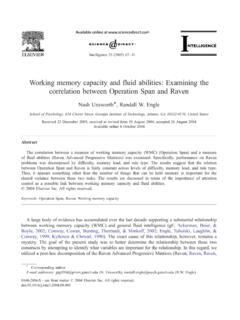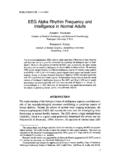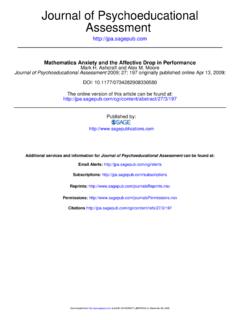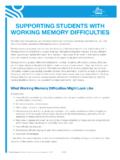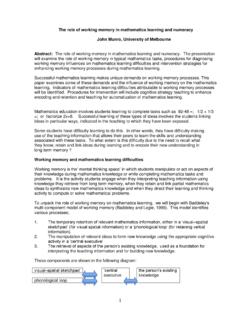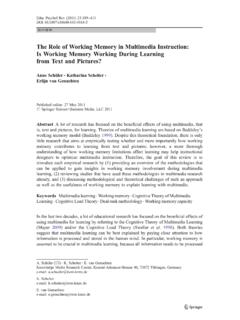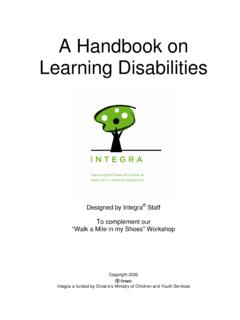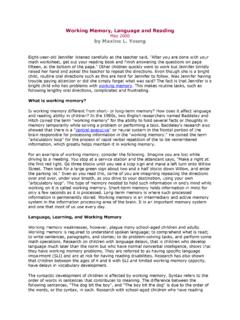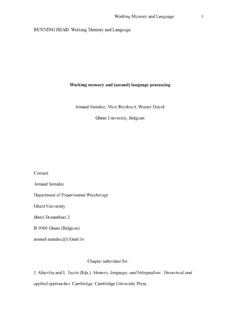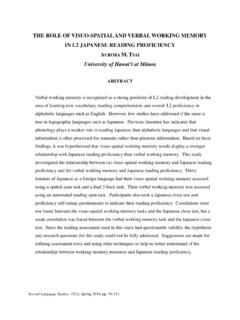Transcription of Learning, working memory, and intelligence revisited
1 Available online at Processes 78 (2008) 240 245 Short communicationLearning, working memory , and intelligence revisitedElaine Tamez , Joel Myerson, Sandra HaleDepartment of Psychology, Washington University, One Brookings Drive, Box 1125, St. Louis, MO 63130, United StatesReceived 8 September 2007; accepted 11 January 2008 AbstractBased on early findings showing low correlations between intelligence test scores and learning on laboratory tasks, psychologists typically havedismissed the role of learning in intelligence and emphasized the role of working memory instead. In 2006, however, Williams developed averbal learning task inspired by three-term reinforcement contingencies and reported unexpectedly high correlations between this task and Raven sAdvanced Progressive Matrices (RAPM) scores [Williams, , Pearlberg, , 2006.]
2 learning of three-term contingencies correlates with Ravenscores, but not with measures of cognitive processing. intelligence 34, 177 191]. The present study replicated this finding: Performance on thethree-term learning task explained almost 25% of the variance in RAPM scores. Adding complex verbal working memory span, measured usingthe operation span task, did not improve prediction. Notably, this was not due to a lack of correlation between complex working memory span andRAPM scores. Rather, it occurred because most of the variance captured by the complex working memory span was already accounted for by thethree-term learning task. Taken together with the findings of Williams and Pearlberg, the present results make a strong case for the role of learningin performance on intelligence tests.
3 2008 Elsevier All rights : intelligence ; learning ; Three-term contingency1. IntroductionAlthough psychologists generally agree on the importanceof assessing intelligence , there has never been a consensusas to the exact nature of this construct ( intelligence and itsMeasurement: A Symposium, 1921; Neisser, 1981; Neisser etal., 1996; Sternberg and Detterman, 1986). There is even a lackof agreement on whether intelligence is comprised of one fac-tor ( g ;Jensen, 1968; Spearman, 1927), two factors, ( , fluidvs. crystallized;Horn and Cattell, 1966), or many factors ( ,either multiple factors or a hierarchy of factors;Carroll, 1993;Sternberg, 1985).
4 Recently, there has been growing interest in the rela-tion between working memory and intelligence . Indeed, someresearchers ( ,Engle et al., 1999; Engle, 2002; Kyllonen andChristal, 1990) have claimed that working memory capacityisintelligence. In contrast,Ackerman et al. (2002, 2005)argued,based on both a single study including an unusually large num-ber of ability measures and a meta-analysis of 86 samples, that Corresponding Tamez). working memory and intelligence are not isomorphic, and thatworking memory is just one of a number of highly the midst of the controversy concerning the role of workingmemory and intelligence , a new study byWilliams and Pearlberg(2006)suggests that learning , in particular learning three-termcontingencies, may be even more predictive than working mem-ory in predicting intelligence (Snow et al.
5 , 1984). The Williamsand Pearlberg findings stand in contrast to early findings show-ing low correlations between learning on laboratory tasks andintelligence test scores (Woodrow, 1938, 1946), which causedmany researchers to dismiss the role of learning in their first experiment,Williams and Pearlberg (2006)foundthat their three-term learning task correlated with the Raven sAdvanced Progressive Matrices (RAPM) (Raven et al., 1998),but two other learning tasks ( , free recall and paired asso-ciates) did not. In a second experiment, they observed that thethree-term learning task did not correlate with working memoryand processing speed, despite the fact that these measures alsocorrelated with the RAPM, which is the gold standard mea-sure of fluid intelligence .
6 Taken together, these findings stronglysuggest that learning may be an important contributor of uniquevariance in intelligence test scores, contrary to previous reports0376-6357/$ see front matter 2008 Elsevier All rights Tamez et al. / Behavioural Processes 78 (2008) 240 245241that individual differences in working memory capacity explainnearly all of the studies examining the correlations among several cog-nitive tests report positive correlations between all cognitivemeasures (for a review, seeAckerman et al., 2005), which arepresumed to indicate the existence of a general ability ( g ) com-mon to all measures (Spearman, 1927). Williams and Pearlberg sfailure to find significant correlations between their learning taskand speed and working memory is contrary to such findings.
7 Tofurther test whether learning and working memory make inde-pendent contributions to predicting performance on intelligencetests, the present study examined the relation between three-term contingency learning (using both a verbal and nonverbalversion of this task), working memory (using both verbal andnonverbal), and fluid intelligence (using the RAPM).2. ParticipantsSixty Washington University undergraduates (30 male and 30female) participated. Participants completed a health question-naire form to screen for visual problems, neurological disease,and depression. In addition, a near vision acuity test was admin-istered using a Wormington Card (Guilden Ophthalmics, ElkinParks, PA) to ensure that participants would be able to accuratelyperceive the stimuli on the computer ApparatusStimuli for the computerized tasks were presented on a30 cm 23 cm flat screen monitor equipped with TouchwareSoftware S64 SR4 (3M Touch, St.)
8 Paul, MN). All computerizedtasks were programmed in E-prime (Psychology SoftwareTools, Pittsburgh, PA). Responses were made either using a com-puter mouse, the computer keyboard, or vocally (and recordedusing an Olympus VN-900PC digital recorder). ProcedureEach participant completed a 2-h session individually. Fol-lowing the health questionnaire and vision test, participantsperformed the following sequence of tasks: the WAIS IIIvocabulary test (Psychological Corporation, 1997), the verbalthree-term learning task, a verbal working memory task, theRAPM, a nonverbal three-term learning task, and two nonver-bal working memory tasks.
9 Participants were given a brief breakevery 30 min throughout the Verbal three-term contingency learning taskIn this verbal learning task (Williams and Pearlberg, 2006),participants were told to learn the associations between eachof the ten cue words ( , lie) and the list of three associatedmemory items ( , fan, rim, dry). There were four blocks oflearning trials, each of which was followed by a test block. Boththe learning and test blocks were 1. Examples of learning and test trials from the verbal three-term learning trials, participants were first shown a cue word( , lie) followed by the prompt, press A , as shown inFig. the participant pressed the cued letter, the prompt disap-peared and the cued letter A and the associated memory item( , fan) appeared in the bottom right hand of the screen.
10 Thecue word, letter, and the memory item remained on the screenuntil the participant pressed the enter key. Then, the cue word( , lie) was shown again followed by the second prompt ( , press B ) and after pressing the cued letter, the letter B andthe second memory item ( , rim) remained on the screen untilthe participant pressed enter. The third prompt ( , press C )then appeared beneath the cue word. Again, the prompt disap-peared once the participant pressed the cued letter, and the letter C and the third memory item ( , dry) appeared in the bot-tom left of the screen. For each learning block, this cycle wasrepeated until all of the 10 cue words with their 3 associatedmemory items had been presented.
